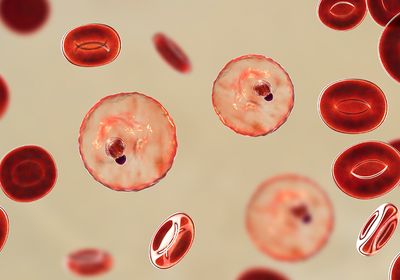ABOVE: By harnessing the power of mRNA technology, a new malaria vaccine provides immunity to multiple Plasmodium parasites before they can escape the liver to infect red blood cells, even with prior infection. © iStock, Dr_Microbe
Malaria remains a key target for infectious disease prevention, particularly with resistance to common antimalarial drugs on the uptick.1 However, a broadly effective vaccine for the deadly disease has remained elusive. Now, in a Nature Immunology paper, researchers reported a new mRNA vaccine that induced a tailored immune response in the livers of mice via the activation of liver-specific tissue resident memory T cells (Trm cells), which control early stages of infection and prevent illness.2 With further development, the vaccine could level the playing field in the fight against malaria.
Researchers developed previous malaria vaccines such as RTS,S/AS01 based on a peptide subunit approach; these have only been mildly effective.3 "With RTS,S/AS01, they’re only targeting the window between infection and the transition of those parasites from the skin to the liver. It’s an incredibly short period of time: about two to three hours,” said Lauren Holz, a microbiologist and immunologist from the University of Melbourne and coauthor of the current study.
Holz and her colleagues were inspired by the success of mRNA vaccines during the COVID-19 pandemic. “By using an mRNA-based vaccine, you can encode an entire protein. That means you can expand the epitope range that your Trm cells are targeting,” Holz remarked.
See also "Malaria Parasites Sync with Hosts’ Molecular Rhythms"
The team developed a novel vaccine that contains an mRNA sequence for ribosomal protein L6 (RPL6), a highly conserved Plasmodium protein. This protein is expressed consistently while the parasites are incubating inside the liver; in humans, this duration is about one week.
Liver Trm cells, which the authors found to be responsible for defense against malaria infection in a previous study, are critical for the efficacy of the vaccine.4 With the inclusion of a chemically-modified glycolipid adjuvant, α-galactosylceramide (αGC), the mRNA vaccine causes a small amount of inflammation in the liver that subsequently elicits a robust immune response from the Trm cells. “Originally, we were using [αGC] in cancer research because of the type of immune response it stimulates; it really activates the antigen-presenting cells to make T cell responses. It was really serendipitous that it worked so well in the liver,” said chemist and coauthor Gavin Painter, from the Victoria University of Wellington.
The researchers tested the vaccine along with other available malaria vaccines in mice. Animals treated with the mRNA vaccine had significantly increased liver Trm cell accumulation and were able to resist infection with sporozoites, which drive the early stages of Plasmodium infection. Importantly, the new vaccine was effective even in animals with prior malaria infection, an obstacle that other vaccines failed to overcome.
See also "In Vitro Malaria Sporozoite Production May Lead to Cheaper Vaccines"
Malaria immunology and vaccinology expert Patrick Duffy of the National Institute of Health, who did not contribute to the study, is enthusiastic about the potential of this new vaccine in malaria prevention. “It’s the combination of bringing mRNA vaccines into the malaria field and how this can be tailored to the specific kind of response that is needed for this particular type of vaccine,” Duffy commented. “It is very exciting and clever that they married these two different approaches.”
References
- Plowe CV. Malaria chemoprevention and drug resistance: a review of the literature and policy implications. Malar J. 2022;21(1):104.
- Ganley M, et al. mRNA vaccine against malaria tailored for liver-resident memory T cells. Nat Immunol. 2023;24(9):1487-1498.
- Laurens MB. RTS,S/AS01 vaccine (MosquirixTM): an overview. Hum Vaccin Immunother. 2020;16(3):480-489.
- Fernandez-Ruiz D, et al. Liver-resident memory CD8+ T cells form a front-line defense against malaria liver-stage infection. Immunity. 2016;45(4):889-902.







